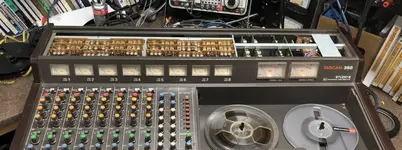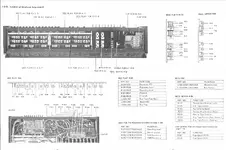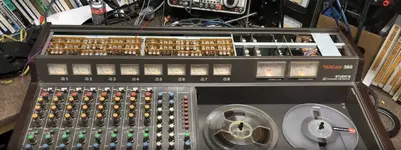B
babecityrecords
New member
Hey all (and Sweetbeats, hero of analog advice on homerecording.com)
Once again returning to humbly ask for some advice on a Tascam 388 issue.
First, Sweetbeats, I feel bad for not following up on that other static issue I had that comes and goes -- it's not bleeding on the tracks so I'm not worried about it anymore.
Onto my real issue...
Recently, I noticed Track 3 is super quiet when recording, in addition to Track 1 (which has always been quiet, normally I just use this track for a metronome). Track 1 is a different story though, that channel has always been quiet.
I tried recording some acoustic guitar yesterday on Track 3 with a bandmate over, and listening back, the guitar was barely audible with two different type of mics (RE20, SM58) inches from the strings. Tried different mics, different XLRs, mic placement -- all super quiet. So ended boosting the trim almost to the max just to get some sound, and the guitar came in, but was so ultra super bass heavy and distorted in RMX/playback, that it sounded just awful... not in a cool lo-fi way.
When in monitoring mode, like right before I hit record to test the level, the guitar/track sounds perfectly audible and fine though.. not sure what's going on with Track 3 when it's actually recording.
All other tracks besides 1 + 3 are great.
I'm wondering, I heard that when take the top panel off the tascam (how I adjusted the tension arms to fix the time monitoring screen ages ago), you can adjust two "knobs" with a small screwdriver to boost the input gain for individual tracks. I'm curious if I can boost the baseline gain level on tracks 1+3 to make them more audible, so I don't have to boost the trim when recording quieter instruments. Also hoping I can avoid taking the whole damn thing apart again (as I did when Sweetbeats walked me through lubing that bad boi up a few months back).
SO-- three baseline questions!
A) Does anyone know which knobs (pictures attached) correspond with tracks 1 + 3 gain levels?
B) Is it a bad idea to adjust these gain levels? I know things will sound a little crunchier, but as long as that's not significantly boosting the bass I think that's fine with the style of music I'm recording.
C) Is this whole plan garbanzo beans and I should do something else first before adjusting the baseline gain levels on these two quieter tracks?
THANK YOU FOR ANY HELP!!
Once again returning to humbly ask for some advice on a Tascam 388 issue.
First, Sweetbeats, I feel bad for not following up on that other static issue I had that comes and goes -- it's not bleeding on the tracks so I'm not worried about it anymore.
Onto my real issue...
Recently, I noticed Track 3 is super quiet when recording, in addition to Track 1 (which has always been quiet, normally I just use this track for a metronome). Track 1 is a different story though, that channel has always been quiet.
I tried recording some acoustic guitar yesterday on Track 3 with a bandmate over, and listening back, the guitar was barely audible with two different type of mics (RE20, SM58) inches from the strings. Tried different mics, different XLRs, mic placement -- all super quiet. So ended boosting the trim almost to the max just to get some sound, and the guitar came in, but was so ultra super bass heavy and distorted in RMX/playback, that it sounded just awful... not in a cool lo-fi way.
When in monitoring mode, like right before I hit record to test the level, the guitar/track sounds perfectly audible and fine though.. not sure what's going on with Track 3 when it's actually recording.
All other tracks besides 1 + 3 are great.
I'm wondering, I heard that when take the top panel off the tascam (how I adjusted the tension arms to fix the time monitoring screen ages ago), you can adjust two "knobs" with a small screwdriver to boost the input gain for individual tracks. I'm curious if I can boost the baseline gain level on tracks 1+3 to make them more audible, so I don't have to boost the trim when recording quieter instruments. Also hoping I can avoid taking the whole damn thing apart again (as I did when Sweetbeats walked me through lubing that bad boi up a few months back).
SO-- three baseline questions!
A) Does anyone know which knobs (pictures attached) correspond with tracks 1 + 3 gain levels?
B) Is it a bad idea to adjust these gain levels? I know things will sound a little crunchier, but as long as that's not significantly boosting the bass I think that's fine with the style of music I'm recording.
C) Is this whole plan garbanzo beans and I should do something else first before adjusting the baseline gain levels on these two quieter tracks?
THANK YOU FOR ANY HELP!!



